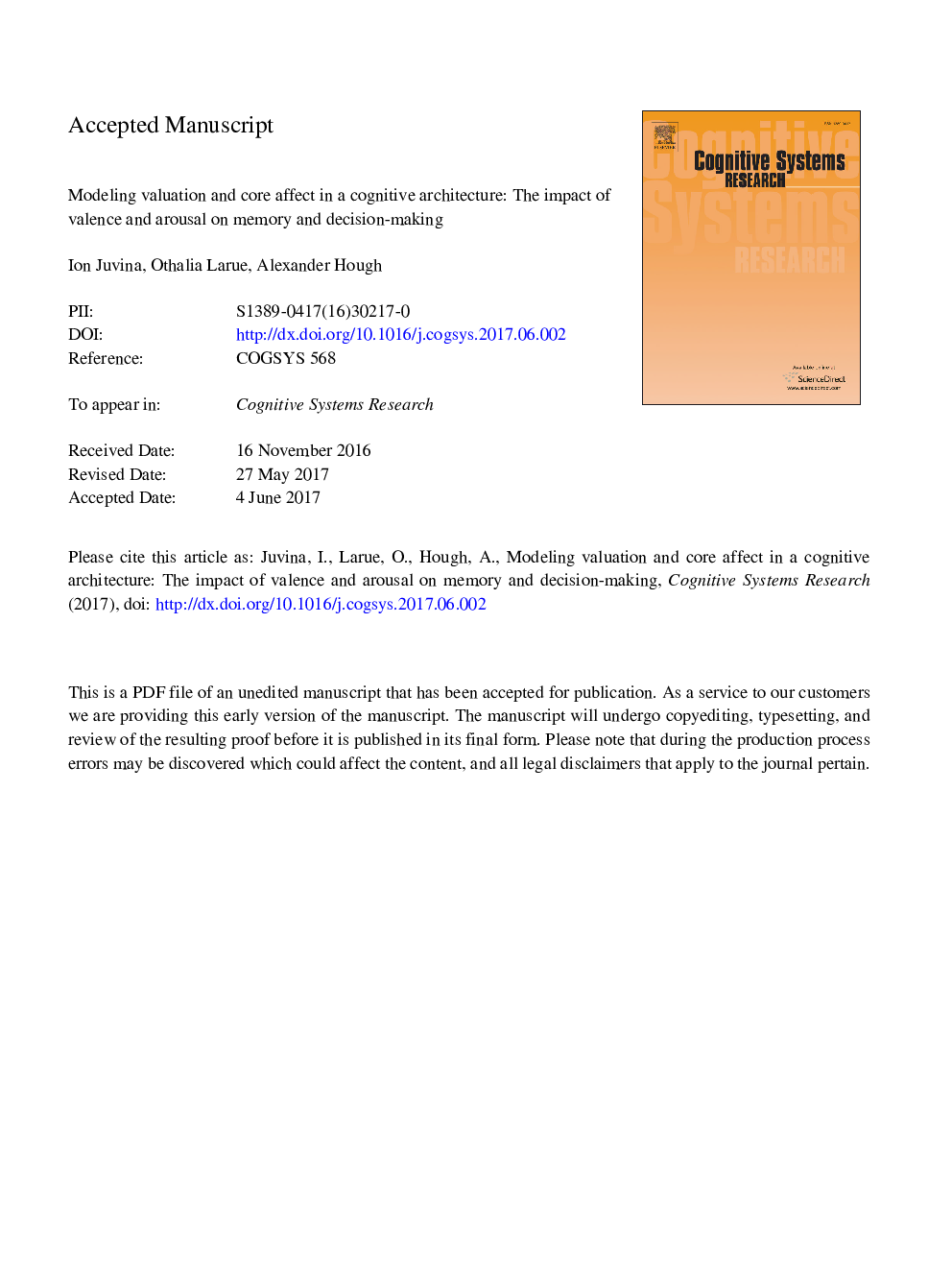| کد مقاله | کد نشریه | سال انتشار | مقاله انگلیسی | نسخه تمام متن |
|---|---|---|---|---|
| 6853804 | 1437245 | 2018 | 42 صفحه PDF | دانلود رایگان |
عنوان انگلیسی مقاله ISI
Modeling valuation and core affect in a cognitive architecture: The impact of valence and arousal on memory and decision-making
ترجمه فارسی عنوان
ارزیابی مدل سازی و هسته در یک معماری شناختی تاثیر می گذارد: تأثیر والنتاین و تحریک در حافظه و تصمیم گیری
دانلود مقاله + سفارش ترجمه
دانلود مقاله ISI انگلیسی
رایگان برای ایرانیان
کلمات کلیدی
معماری شناختی، مدل سازی شناختی محاسباتی، ارزیابی، هسته تاثیر می گذارد، حافظه، تصمیم سازی،
ترجمه چکیده
یک رویکرد جدید برای افزودن قابلیت های ارزیابی اولیه به یک معماری شناختی پیشنهاد شده است. دو عدد سمبلیک به نام ارزیابی و تحریک برای هر عنصر حافظه اعلام شده بر اساس آمار استفاده و پاداش آن تولید می شود. در نتیجه، هر عنصر حافظه می تواند به عنوان مثبت یا منفی مشخص و دارای درجه خاصی از شدت عاطفی است. به نوبه خود، این ویژگی ها تأخیر و احتمال بازیابی آن عنصر حافظه را تحت تاثیر قرار می دهد. دو باتری جهانی به نام ارزیابی تاثیر هسته و تحریک هسته-تاثیر آن به ترتیب به عنوان مقادیر وزنی تمام ارزیابی های قابل بازیابی و برون گرا محاسبه می شوند. وزنها منعکس کننده تاریخچه استفاده، ارتباط موضوع و پاداش تعهد برای تمام عناصر حافظه قابل بازیابی است. این باتری ها حالت عمومی یا حالت سیستم را توصیف می کنند. هسته اثر دینامیک به عنوان سیگنال پاداش برای یادگیری ارزش گذاری و ارزش تحریک برای اشیاء جدید یا رویدادها استفاده می شود. مکانیسم جدید معماری برای توسعه دو مدل استفاده می شود که نشان دهنده تأثیر والنتای عاطفی و تحریک در حافظه و تصمیم گیری است. مدل ها متناسب با مجموعه داده ها از ادبیات و پیش بینی های جدید هستند. ارزش شامل ارزیابی و مکانیسم هسته تحت تأثیر مکانیسم در یک معماری شناختی مورد بحث قرار گرفته است.
موضوعات مرتبط
مهندسی و علوم پایه
مهندسی کامپیوتر
هوش مصنوعی
چکیده انگلیسی
A novel approach to adding primitive evaluative capabilities to a cognitive architecture is proposed. Two sub-symbolic quantities called valuation and arousal are learned for each declarative memory element based on usage statistics and the reward it generates. As a result, each memory element can be characterized as positive or negative and having a certain degree of affective intensity. In turn, these characteristics affect the latency and probability of retrieval for that memory element. Two global accumulators called core-affect-valuation and core-affect-arousal are computed as weighted sums of all retrievable valuations and arousals, respectively. The weights reflect usage history, context relevance, and reward accrual for all retrievable memory elements. These accumulators describe the general disposition or mood of the system. Core affect dynamics are used as reward signals to learn valuation and arousal values for new objects or events. The new architectural mechanism is used to develop two models that demonstrate the impact of affective valence and arousal on memory and decision-making. The models are fit to datasets from the literature and make novel predictions. The value of including valuation and core affect mechanisms in a cognitive architecture is discussed.
ناشر
Database: Elsevier - ScienceDirect (ساینس دایرکت)
Journal: Cognitive Systems Research - Volume 48, May 2018, Pages 4-24
Journal: Cognitive Systems Research - Volume 48, May 2018, Pages 4-24
نویسندگان
Ion Juvina, Othalia Larue, Alexander Hough,
